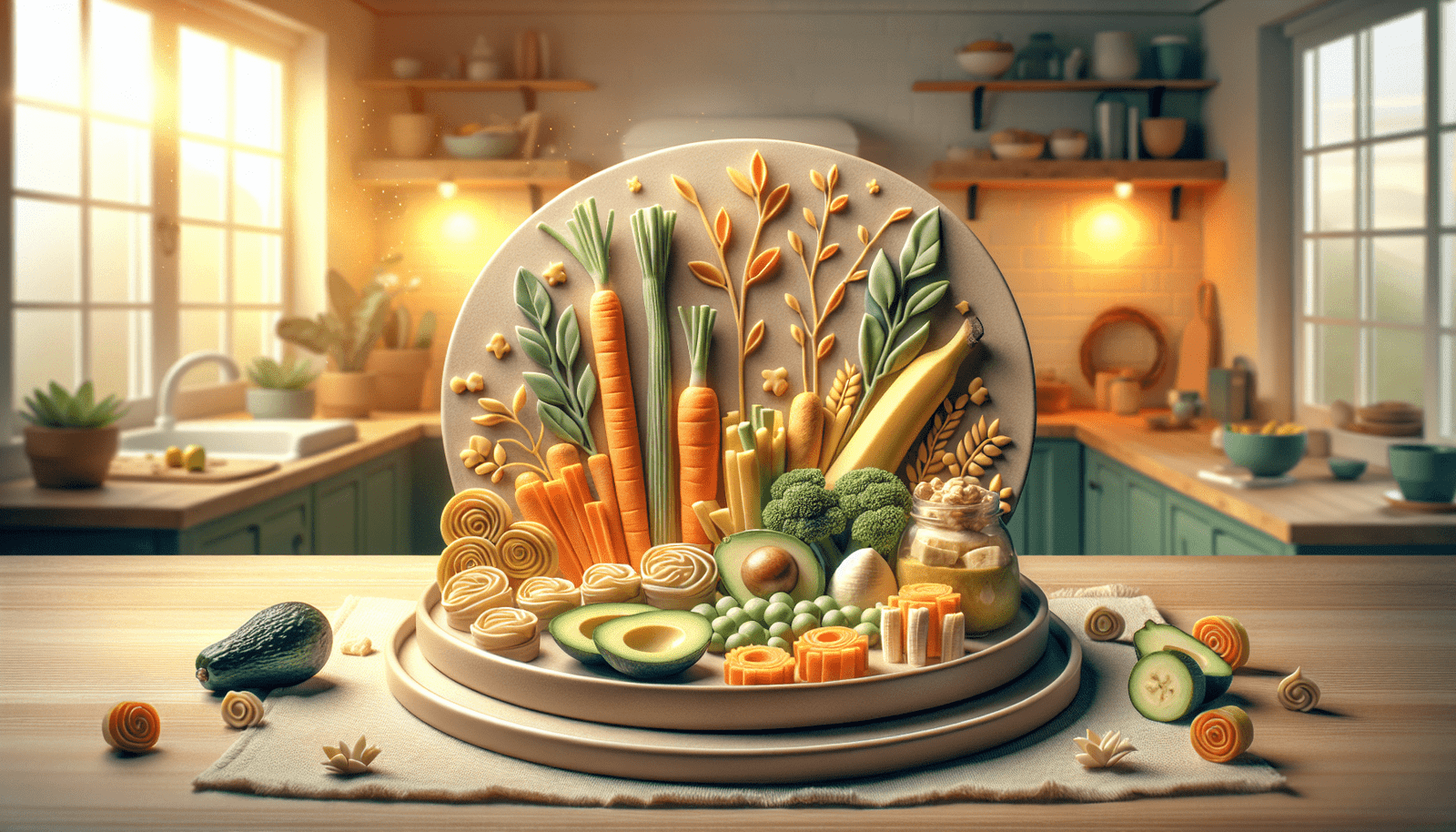Have you ever wondered how much food you should offer your baby when starting baby-led weaning? It’s a common question that many parents have as they navigate this exciting stage of their child’s development. Knowing how much food to present can help ensure that your little one gets the nutrition they need while enjoying the process of feeding themselves. Let’s break this down together.
What is Baby-Led Weaning?
Baby-led weaning (BLW) is an approach to introducing solid foods that allows your baby to feed themselves from the start. Rather than spoon-feeding purees, you present whole pieces of food that your little one can grasp and explore. This method encourages independence, motor skill development, and a positive relationship with food.
It’s all about allowing your baby to decide what and how much they want to eat. But how do you determine what that looks like regarding portion sizes? Let’s find out.
Understanding Portion Sizes for Babies
Factors to Consider
When determining the right amount of food for your baby, keep in mind several factors that can influence their appetite and food intake:
- Age and developmental stage: As your baby grows, their nutritional needs and appetites will change. Typically, babies start eating solids around six months of age. At this stage, small portions are ideal.
- Individual appetite: Just like adults, babies have their own unique appetite, which can vary from day to day. Some days, they might eat heartily, while on others, they may be less interested.
- Types of foods presented: The texture and type of food can also impact how much your baby eats. Softer foods can be easier to handle and consume, while firmer foods might require more effort and may be left uneaten.
General Portion Guidelines
While there are no strict rules, general guidelines can help you gauge how much food to present:
- Begin with 1 to 2 tablespoons of each food type for a meal. This will allow your baby to experiment without overwhelming them.
- Gradually increase the portion sizes as your baby becomes more adept at eating. You can offer more variety without necessarily increasing the quantity at the beginning.
Here’s a quick reference table for a general idea of portion sizes based on age:
| Age (Months) | Food Portion (Approx.) |
|---|---|
| 6 – 8 | 1 to 2 tablespoons per food type |
| 9 – 12 | 2 to 4 tablespoons per food type |
| 12 – 24 | 4 to 6 tablespoons per food type |
Observing Your Baby’s Cues
Recognizing Hunger and Fullness
Understanding your baby’s hunger and fullness cues is essential. Babies are great at self-regulating their food intake, and it’s important to pay attention to these signals.
- Hunger cues: Look for signs that indicate your baby is interested in food, such as reaching for the food, opening their mouth, or smacking their lips.
- Fullness cues: Your baby may turn their head away, push the food away, or become distracted when they’ve had enough. Trust these cues instead of trying to get them to eat more.
Feeding at Your Baby’s Pace
Allowing your baby to eat at their own pace helps them develop a healthy relationship with food. If they’re interested, let them explore, play, and taste.
Variety of Foods for Baby-Led Weaning
Introducing Different Food Groups
Incorporating a variety of foods into your baby’s diet is essential for balanced nutrition. Here’s a breakdown of food types you can offer, along with suggested portion sizes:
| Food Group | Examples | Portion Size |
|---|---|---|
| Vegetables | Steamed carrot sticks | 1-2 sticks |
| Fruits | Banana slices, avocado | 1/2 piece |
| Grains | Soft whole grain toast | 1/4 slice |
| Protein Sources | Chicken, fish, tofu | 1-2 tablespoons |
| Dairy (if applicable) | Plain yogurt, cheese | 1 tablespoon |
How to Prepare Foods for Your Baby
Preparing food for baby-led weaning doesn’t have to be complicated. Ensuring that foods are appropriately sized and cooked can greatly enhance your baby’s experience:
- Soft-cooked vegetables: Steam or roast until they are tender and easy to grasp.
- Fruits: Cut into manageable pieces or serve ripe fruits that are easy for your little one to mash with their gums.
- Protein: Offer soft, shredded meats or well-cooked beans.
Balancing Quantity and Quality
Quality Matters
While portion sizes are important, the quality of the food you’re offering should also be a priority. Focus on nutrient-dense foods that will support your baby’s growth and development.
- Avoid processed foods: These can be high in sugar, salt, and unhealthy fats. Opt for whole, fresh options instead.
- Variety over quantity: It’s not just about how much food your baby eats but also about ensuring they experience different flavors and textures.
Meal Frequency
For most babies starting on solids, three meals a day with one or two snacks work well. You don’t have to pressure yourself into an exact schedule. Pay attention to your baby’s natural rhythm and adjust mealtimes accordingly.
Safety Considerations
Supervision During Mealtime
Never leave your baby unattended during mealtimes. Choking is a risk, especially when they are exploring new textures. Be present and attentive to supervise your baby as they eat.
Modifying Foods for Safety
To minimize choking hazards, ensure that the pieces of food you serve are adequately sized. Generally, aim for food items the size and shape of your baby’s fist. Also, avoid foods that are hard, round, or sticky, as these can pose risks.
Gradually Increasing Portions
Signs to Increase Portions
As your baby becomes more comfortable with eating and shows interest in food, you can start gradually increasing portion sizes. Some signs that your baby may be ready for more:
- They consistently finish meals or show an interest in more.
- They demonstrate improved motor skills and confidence in self-feeding.
Adjusting Based on Age and Activity Level
As your baby grows, keep in mind their age and activity level. An active, crawling baby might require more calories than a baby who is less mobile. You know your baby best, so trust your instinct to adjust portion sizes as needed.
Meal Ideas for Baby-Led Weaning
Sample Meal Ideas
Creating meals that are both nutritious and enjoyable can be a fun part of the baby-led weaning journey. Here are some ideas for meals that you can offer:
- Breakfast: Soft scrambled eggs, whole grain toast with avocado, and a side of banana slices.
- Lunch: Soft-cooked sweet potato wedges, strips of chicken breast, and steamed green beans.
- Dinner: Pasta with a light tomato sauce, cut into manageable pieces, and small pieces of soft broccoli.
Snack Suggestions
Snacks are an excellent opportunity to introduce more flavors and nutrients throughout the day. Consider these snacks:
- Full-fat yogurt with mashed fruit.
- Oatmeal cookies made with mashed banana and oats.
- Soft, cubed cheese.
When to Seek Professional Guidance
Consulting a Pediatrician
While baby-led weaning is generally safe and beneficial, if you have specific concerns about your baby’s food intake or nutritional needs, don’t hesitate to reach out to a pediatrician or a nutritionist. They can provide personalized guidance based on your baby’s growth and dietary requirements.
Food Allergies and Sensitivities
If you suspect any allergies or sensitivities to certain foods, it’s key to consult with a healthcare professional. It’s vital to proceed carefully when introducing potential allergens to ensure a safe and enjoyable experience for your baby.
Building Positive Mealtime Experiences
Creating a Comfortable Environment
To enhance your baby’s feeding experience, establish a positive atmosphere during mealtimes. Make sure the dining area is inviting and free from distractions. This allows your baby to focus on exploring their food.
Encouraging Family Meals
Sharing meals as a family can be an excellent way to model positive eating habits. Eating together helps create social interactions around food, and your baby will benefit from observing you enjoying different foods.
Conclusion
The journey of baby-led weaning is as much about developing a healthy relationship with food as it is about nutrition. You now have a clearer understanding of how much food to offer your baby, along with practical tips for creating a positive eating experience. Remember to keep it fun and flexible as you let your baby explore different tastes and textures.
Trust your intuition and your baby’s cues as they learn this important skill. With time, patience, and encouragement, your little one will develop the abilities they need to thrive. Enjoy this wonderful adventure together!

